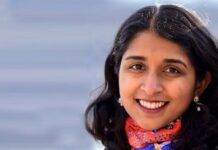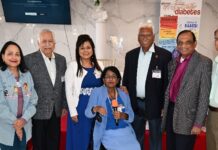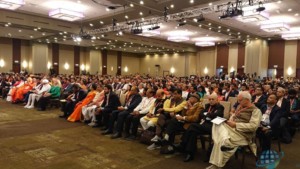
Sunthar Visuvalingam
CHICAGO: World Hindu Congress 2018 from September 7 to 9 at the Westin Hotel, Lombard, Illinois, summed up its eight parallel conference tracks on its last day plenary, where track leaders also attempted to build synergies among their otherwise distinct collective initiatives.
It was decided to “establish a trans-continental task force” with a permanent secretariat in US or UK, recruit an eminent person to formulate a vision, set timelines, and develop a comprehensive global database of Hindu politicians and their organizations. No explanation was offered for several announced politicians – from India, US and elsewhere and the US – not having shown up at the conference and the possible implied challenges.
Sanjay Puri, Chairman of the US-India Political Action Committee (USINPAC), listed the issues discussed at the Hindu Political Conference as: “reasserting a strong political voice in Caribbean, Fiji, African countries; expanding and cultivating political leadership in Western democracies; collective strategies to address complex challenges; empowering and mentoring the next generation and overcoming the “general apathy of Hindus.”
Hindu Media conference coordinator Sushil Pandit stated that its six lively sessions featured 24 speakers and 100 questions. A key thread was the shift of emphasis from “fake news” of which numerous examples had been cited to “fake narratives” where even (half) truths are shorn if their context to denigrate the community. Technology discussions converged on social media becoming increasingly customized, drawing on multiple sources to cater to fragmenting audiences. Entertainment should showcase Hindus by writing books, making films, without cribbing, remaining “cool,” relevant and hard-hitting.
Among the media participants were Amish Tripathi, whose prolific fiction has galvanized renewed interest in Hindu mythology among skeptical youth; and Vivek Agnihotri, whose movie and book on urban Naxals amounts to a powerful intervention in the contemporary ideological battle.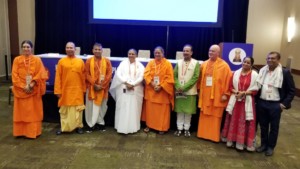
In attempting to raise awareness of investment opportunities in India and foster dialogue with U.S. corporations, Hindu Economic Forum discussed trade and reforms, leadership and growth, business access, and startup ecosystem. Creation of Hindu Diaspora Bond was considered given that they save a billion dollars annually in the Americas alone.
BL Ramaratna stated that 230 delegates of diverse backgrounds from 12 countries participated in the Hindu Women conference that, like the Youth conference, covered practically every WHC 2018 track. National President of the Hindu Students Council Parth Parihar outlined the intersections between the special needs of Hindu Youth and the issues addressed by the other tracks: recognition of talent, mentorship, local and global support networks were among the common themes.
For a key obstacle to strengthening Hindu identity is youthful ignorance, worsened by biased textbooks as in the California case study. Their naturally futuristic outlook was tapped into in an exploration of blockchain “as a decentralized quasi-dharmic model for the 21st century” and cluster model for the new economy.
Hindu Organizational (HOTA) conference coordinator Guna Magesan from New Zealand restated its aim “to bring organizations, temples, language- and community-based groups under a single umbrella toward Hindu resurgence. Among the tasks identified were freeing temples from clutches of the government, defending human rights not only of Hindus, especially in Bangladesh and Pakistan, but also of kindred communities, such as Roma and Yazidis, around the globe.
Magesan, who has pioneered a Hindu-Maori interface, underlined ancient cultural commonalities with indigenous peoples in South America and elsewhere. Having already created a strong, visible Hindu identity in North America, “a national conference on Hindu contributions to American society” is being planned.
Hindu Educational conference facilitator Nachiketa Tiwari elaborated its mission of “quality education for all”: role of institution building; networking to support Hindu scholarship; strengthening knowledge tradition and indigenous languages; responding to Western academic challenges and global perspectives. Delegates from 30 countries highlighted the centrality of independent and self-confident scholarship. The need for a strong international network of Hindu scholars, both traditional and academic, was recognized, with several spiritual organizations already running their own universities.
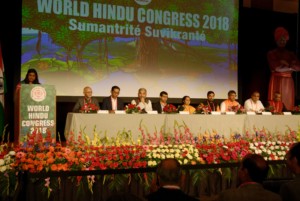 New to this second congress was the poster competition: 56 posters from India, Finland, Japan, Kenya, North America were displayed along the main corridors on themes broadly aligned with the above seven tracks. Attendees observed and participated in animated conversations around these posters. The top three judged on quality, clarity and impact were on 1) toilet and hygiene project for the girl child, 2) Pakistani Hindus – a genocide forgotten, and 3) Hindu culture through stories from gurukula.com.
New to this second congress was the poster competition: 56 posters from India, Finland, Japan, Kenya, North America were displayed along the main corridors on themes broadly aligned with the above seven tracks. Attendees observed and participated in animated conversations around these posters. The top three judged on quality, clarity and impact were on 1) toilet and hygiene project for the girl child, 2) Pakistani Hindus – a genocide forgotten, and 3) Hindu culture through stories from gurukula.com.
WHC2018seems to have indeed lived up to its mission to “provide a global platform for Hindus to connect, share ideas, inspire one another, and impact the common good” under the philosophical banner of “think collectively, achieve valiantly” (sumantritésuvikranté).
To create awareness about atrocities committed against Hindus around the world, Hindu youth should leverage their social media skills, speak out against biased portrayals of Hindus, educate emerging politicians on the effective use of media and identify the key roadblock to Hindu youth in embracing their Hindu identity proudly were key points.
The conference has decided to establish at least 20 internships for youth who aspire to enter politics.
Entrepreneur and Grammy nominated artist Chandrika Tandon shared her insights at the women’s conference. A short term goal was to conduct value based workshops, seminars and symposiums for young girls. Long term goals were an Angel Investor group for women entrepreneurs and a global Hindu Women Business directory.
A strategy for developing scholarship in religious studies and a strong international network of Hindu scholars were the outcomes of the Education conference.
Mohandas Pai, Sonal Mansingh, and Nagaswamy shared the dais for the third plenary session on Hindu Society: Glory of the Past, Pain of Present and Dream for Future. Prof. Subhash Kak moderated the session.
“We have a lot to be proud of,” said Subhash Kak and highlighted the many inventions and scientific theories of today that have already been written about in ancient literary works such as the significance of the number 108. The true father of computer science should be Panini for his 4000 rules of Sanskrit language, he said, and the inventor of quantum mechanics is said to have said that the concept came to him from the Upanishads.
Renowned classical dancer Sonal Mansingh spoke about “Kala, Sanskriti and Vidya” and how one is always seeking eternal life in this ephemeral life. This can be achieved by Nritya, which not just dance. Every breath you take is a dance, the blood flowing in your veins is a dance, the heart beat is taal. Even the word Bharath has music in it – as Bha means love, Ra means raga and ta means taal.
- Nagaswamy, historian and archeologist from Tamil Nadu, spoke about Manu Dharma which is derived from the Vedas. This was the first constitution and law code established 3500 years ago. Manu Dharma describes how a child should be raised, how a king should rule, crime and punishment, among other things. These “laws” or Manu Dharma should be established by great, learned people, who must be honest and have no hatred, enmity or greed, he said. These laws inscribed on copper plates have been found in ancient kingdoms across the Indian subcontinent.
The organizers announced that the third World Hindu Conference will be held in Bangkok, Thailand, from Nov. 4 to 6, 2022. The conference theme will be “Victory of dharma, not adharma.”
Full information regarding schedule, speakers, etc., may be found at the WHC 2018 official website: http://www.worldhinducongress.org/





